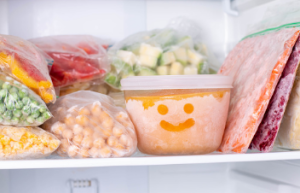How to Store Frozen Fruits and Vegetables
November 21, 2022
Less susceptible to spoilage
Food spoilage is caused by various factors, including temperature, light, humidity, and spoilage bacteria. These bacteria can be harmful to humans and can cause unpleasant tastes. Meat, poultry, and milk are common food items susceptible to spoilage. These bacteria produce toxins and waste products, which are unhealthy for consumers.
 Food that has been frozen is less susceptible to microbial spoilage. While freezing does not kill bacteria and germs, it does put them into hibernation. As soon as the food thaws, bacteria and germs will re-emerge. As food thaws, moisture content increases, which is necessary for bacteria.
Food that has been frozen is less susceptible to microbial spoilage. While freezing does not kill bacteria and germs, it does put them into hibernation. As soon as the food thaws, bacteria and germs will re-emerge. As food thaws, moisture content increases, which is necessary for bacteria.
Improved nutritional value
A recent study from the University of Georgia suggests that consumers should consider buying frozen fruits and vegetables as an alternative to fresh produce. The researchers looked at the nutrient content of eight commonly purchased frozen fruits and vegetables. They found that both options are comparable in their nutritional content. And while the study was limited to fruits, it showed a marked improvement over fresh produce.
Freezing preserves beneficial plant compounds that fight disease and increase the nutritional value of food. Moreover, frozen fruits and vegetables are often more affordable than fresh foods. Another benefit is the wide variety available. It means you can enjoy a consistent variety of fruits and vegetables daily. Plus, frozen fruits and vegetables are generally lower in sugar content.
Markwell Foods NZ frozen food produce also has a longer shelf life. It means that you can enjoy them for longer. Frozen fruits and vegetables contain higher levels of vitamins, minerals and antioxidants than fresh options. Additionally, you can use frozen berries and vegetables in smoothies or stir-frying to make a nutritious meal.
Frozen foods are convenient and easy to prepare. Most consumers still need the recommended daily allowance for fruits and vegetables. However, many consumers are starting to recognise the value of frozen produce. More than three-quarters of shoppers make grocery lists using frozen and fresh ingredients.
In addition to improving the nutritional value of frozen foods, consumers can also add fresh vegetables, whole grains, and protein to these frozen foods. These changes in the food’s composition can help prevent the growth of bacteria and reduce the chances of food waste.
Convenience
One of the main benefits of frozen food is its convenience. It can be cooked and stored without needing a special refrigerator, making it a great option for busy families. Freezing also makes food more affordable and reduces food waste.
Consumers increasingly recognise the convenience and value of frozen food, and their buying habits are changing accordingly. Last year alone, the dollar sales of frozen breakfast meals, sandwiches, waffles, and sausages rose by 8.3%.
Cost
The cost of frozen food can vary considerably depending on the country where you are purchasing the products. Several factors can affect the cost, including the freezer, operation, and repairs. There are also additional costs for the containers, plastic bags, boxes, and foil used in packaging. However, compared to fresh food, the cost of Markwell Foods NZ frozen food is very affordable. Moreover, frozen food is very convenient to use. It can be offered quickly, which is great for restaurants and cafes. Moreover, it can boost a business’s performance and margins.
Storage
The first step in storing frozen foods is to find a suitable container. These containers are often made of glass or plastic. These containers are also often reusable. The next step is to make sure the containers are clean. Ideally, you should choose a material that will prevent ice from forming in your freezer.
When choosing a storage container, consider the size of the freezer. It is important to keep in mind that the space should be proportional to the number of products that need to be stored. Moreover, it would help to choose a storage area with a constant temperature. It will help prevent contamination and injury to the food.
The temperature at which a food freeze depends on the type of aqueous solution contained in the food. As the temperature decreases, the rate of biochemical spoilage is slower. It also reduces the growth of bacteria. Therefore, low-temperature storage is considered to be bactericidal. In addition, most insect activity is suppressed below four o C, although some species can survive in cold temperatures for long periods.
When storing food, you should check it often to determine if it has gone bad or needs to be discarded. For best results, you should eat it within four days of freezing.